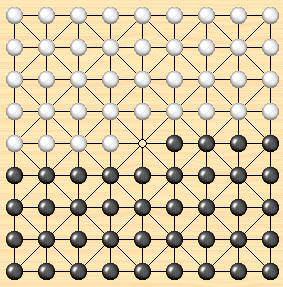

Zamma (Damma, Srand, Dhamet ) is played on a quadruple Alquerque pattern. (Arabic Alquerque is the forefather of checkers.) The Zamma board is quite old. It is believed to be the precursor of the Alquerque board pattern. A Zamma board survives among the roof-slab scribings at Kurna (c. 1400 BCE). However, the present version of Zamma is believed to rely heavily on developments in draughts since the 17th century (a supposition that could be challenged). It is still played in North Africa, where the black pieces are called men, and the white pieces are called women. When played in the Sahara, the men are represented by short sticks, whilst the women are pieces of camel dung. Black makes the first move.
This game is called Srand (or Dhamet ) in Mauritania, where it is the national game. In the particular variant played the captured counters are removed instantly from the board. In other variants the removal of captured pieces is deferred.
Pieces are obliged to follow the pattern on the board. They can only move in the forward directions, however, they can make multiple captures, by the short leap, in any direction. Goal is to capture all the opponent’s pieces. Note that one must always choose the line with the most captures. Pieces are promoted to Mullahs (also called Sultans ) at the last rank. If the counter, during a capturing sequence, makes an intermediate landing on a promotion square, it does not promote to Mullah. The Mullah moves and captures in all directions. It can move any number of squares, like the King in international draughts, and land anywhere behind the captured piece. In one variant it cannot jump repeatedly over an enemy piece, in another variant it can (that is, the captured piece has already been removed). Capture is compulsory.
A piece moves to an empty adjacent point. If an adjacent point is occupied by an enemy piece and the point directly behind is vacant, then one must jump over it and capture it, as in checkers. Several pieces may be captured like this in a single turn.
By way of combinations one must try to attain material advantage, by exchanging one piece for two, or two for three, etc. In the endgame, material advantage generally leads to a win. Mullahs are very powerful, and one can sacrifice pieces to achieve promotion. Remember that men standing on the diagonal matrix have greater scope.
This is an intriguing checkers variant. The counters have different scope depending on which squares they are positioned. On half of the squares they can capture in eight directions, in the other half they can capture in four directions and move in only one. The board pattern allows this freedom of capture directions while half of the diagonals are removed, compared with a checkers board. Possibly this game carries some advantages compared with international draughts, which has become very drawish in grandmaster quarters.
Khreïbga and Felli
Two smaller Zamma variants have also been implemented, namely Khreïbga (5x5), played on a traditional Alquerque pattern (here), where pieces can both move and capture in all directions, and the minimalistic Felli (Fich) from Morocco. In Khreïbga counters can also move backwards and sideways. Counters are obliged to follow the pattern on the board. The pieces can move and capture, by the short leap, in any direction. Goal is to capture all the opponent’s counters. Counters are promoted to Mullahs (Sultans) at the last rank. If the counter, during a capturing sequence, makes an intermediate landing on a promotion square, it does not promote to Mullah. The Mullah moves and captures in all directions. It can move any number of squares, like the king in international draughts, and land anywhere behind a captured piece. Capture is obligatory.
In Felli (Fich ) counters can also move backwards and sideways. The pieces can move and capture, by the short leap, in any direction. Goal is to capture all the opponent’s counters. Counters are promoted to Mullahs (Sultans) at the enemy corner squares. If the counter, during a capturing sequence, makes an intermediate landing on a promotion square, it does not promote to Mullah. The Mullah moves and captures in all directions. It can move any number of squares, like the king in international draughts, and land anywhere behind a captured piece. Capture is obligatory.

Felli
References
Alemanni, Jean-Bernard. Les Jeux de Dames dans le Monde. Techniques, Chiron, Paris (2005)
Mokhtar, Ould Hamidoun. Précis sur la Mauritanie. IFAN Saint-Louis (Mauretania) 1952.
Ol Bah, Abdallahi. Les Dames du Desert, Jeux et Stratégie no.27, June-July 1984.
Pennick, Nigel. Games of the Gods (1988).
Thanks to Peter Michaelsen for providing much valuable information.
☛ You can download my free Zamma program here, (updated 2020-10-16) but you must own the software Zillions of Games to be able to run it.
© Mats Winther 2006